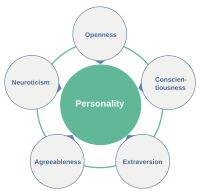
Evaluation of an approach–avoidance training intervention for children and adolescents with obesity: A randomized placebo‐controlled prospective trial
Sign Up to like & getrecommendations! Published in 2018 at "European Eating Disorders Review"
DOI: 10.1002/erv.2607
Abstract: This study evaluated the efficacy of approach-avoidance training as an additional treatment for children and adolescents with obesity seeking inpatient treatment. Two hundred thirty-two participants (8-16 years, 53.9% girls) were randomly assigned either to multisession approach-avoidance… read more here.
Keywords: avoidance training; approach avoidance; children adolescents; approach ... See more keywords

Does Exposure Therapy Lead to Changes in Attention Bias and Approach-Avoidance Bias in Patients with Social Anxiety Disorder?
Sign Up to like & getrecommendations! Published in 2018 at "Cognitive Therapy and Research"
DOI: 10.1007/s10608-018-9934-5
Abstract: Cognitive biases have been suggested to play a crucial role in the etiology and maintenance of social anxiety disorder (SAD). The aim of the present study was to investigate the effects of exposure therapy on… read more here.
Keywords: exposure therapy; approach avoidance; avoidance bias; approach ... See more keywords

Retraining of automatic action tendencies in individuals with obesity: A randomized controlled trial
Sign Up to like & getrecommendations! Published in 2018 at "Appetite"
DOI: 10.1016/j.appet.2018.03.016
Abstract: Obesity is a major health concern, characterized by an automatically activated tendency to (over)-eat. Recent research suggests that an effective way to counteract automatic approach tendencies in unhealthy consumption behavior might be approach bias modification.… read more here.
Keywords: group; pathology; approach avoidance; food ... See more keywords

Approach-avoidance modification as an add-on in smoking cessation: A randomized-controlled study.
Sign Up to like & getrecommendations! Published in 2019 at "Behaviour research and therapy"
DOI: 10.1016/j.brat.2018.12.004
Abstract: Biases in information processing are attributed an important role in the maintenance of tobacco dependence. As these biases are not sufficiently taken into account in current treatments, the aim of the present study was to… read more here.
Keywords: randomized controlled; study; approach avoidance; approach ... See more keywords

Mechanisms underlying approach-avoidance instruction effects on implicit evaluation: Results of a preregistered adversarial collaboration
Sign Up to like & getrecommendations! Published in 2017 at "Journal of Experimental Social Psychology"
DOI: 10.1016/j.jesp.2016.10.004
Abstract: Abstract Previous research demonstrated that mere instructions to approach one stimulus and avoid another stimulus result in an implicit preference for the to-be-approached over the to-be-avoided stimulus. To investigate the mechanisms underlying approach-avoidance (AA) instruction… read more here.
Keywords: instruction; underlying approach; approach avoidance; mechanisms underlying ... See more keywords

A meta-analytic review of Elliot's (1999) Hierarchical Model of Approach and Avoidance Motivation in the sport, physical activity, and physical education literature
Sign Up to like & getrecommendations! Published in 2017 at "Journal of Sport and Health Science"
DOI: 10.1016/j.jshs.2015.07.008
Abstract: Purpose The purpose of this quantitative review was to summarize the state of Elliot's Hierarchical Model of Approach and Avoidance Motivation, specifically the antecedents of the 2 × 2 achievement goals in the sport, physical activity, and… read more here.
Keywords: avoidance motivation; model approach; model; approach avoidance ... See more keywords

Approach and avoidance tendencies in depression and anxiety disorders
Sign Up to like & getrecommendations! Published in 2017 at "Psychiatry Research"
DOI: 10.1016/j.psychres.2017.07.010
Abstract: Anxiety is linked to increased avoidance and inhibition, whereas depression is linked to decreased approach and diminished behavioral activation. Although these notions are widely recognized, systematic investigation of approach-avoidance tendencies is lacking across these diagnostic… read more here.
Keywords: avoidance tendencies; anxiety; trait avoidance; approach avoidance ... See more keywords

Stress, aggression, and the balance of approach and avoidance
Sign Up to like & getrecommendations! Published in 2019 at "Psychoneuroendocrinology"
DOI: 10.1016/j.psyneuen.2019.01.020
Abstract: Stress is a well-established risk factor for many mental disorders including anxiety disorders or substance abuse. A hallmark of these disorders is an imbalance between behavioral approach and avoidance in situations with approach-avoidance conflicts and… read more here.
Keywords: stress aggression; approach avoidance; avoidance;

The role of psychopathic traits, social anxiety and cortisol in social approach avoidance tendencies
Sign Up to like & getrecommendations! Published in 2021 at "Psychoneuroendocrinology"
DOI: 10.1016/j.psyneuen.2021.105207
Abstract: Social anxiety and psychopathy have conceptually been linked to nearly opposite emotional, behavioral and endocrinological endophenotypes, representing social fearfulness and fearlessness, respectively. Although such a dimensional view has theoretical and practical implications, no study has… read more here.
Keywords: anxiety; approach avoidance; psychopathic traits; social anxiety ... See more keywords

Social approach and avoidance in language: N400-like ERP negativity indexes congruency and theta rhythms the conflict.
Sign Up to like & getrecommendations! Published in 2022 at "Cerebral cortex"
DOI: 10.1093/cercor/bhac136
Abstract: Motivational congruency has been examined using tasks where participants perform approach or avoidance movements towards socially positive or negative faces. Language is tightly intertwined with interpersonal cognition. Thus, similar situations could be represented by means… read more here.
Keywords: conflict; approach avoidance; congruency; avoidance ... See more keywords

Elucidating medial temporal and frontal lobe contributions to approach-avoidance conflict decision-making using functional MRI and the hierarchical drift diffusion model.
Sign Up to like & getrecommendations! Published in 2023 at "Cerebral cortex"
DOI: 10.1093/cercor/bhad080
Abstract: The prefrontal cortex (PFC) has long been associated with arbitrating between approach and avoidance in the face of conflicting and uncertain motivational information, but recent work has also highlighted medial temporal lobe (MTL) involvement. It… read more here.
Keywords: conflict; avoidance conflict; evidence; medial temporal ... See more keywords